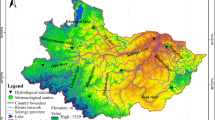Abstract
Understanding changes induced by watershed urbanization is integral to developing an effective long-term management strategy. In this research, the authors study statistical changes of lake water surface levels in two urbanizing watersheds by evaluating serial change in time series parameters, autocorrelation, and variance as well as by developing a regression model to estimate weekly lake level fluctuations. The authors fit a seasonal integrated autoregressive moving average model to lake levels over subperiods of the data record to identify trends in parameter values. The authors fit the regression model with rainfall, lake stage, and temperature components for pre-urbanized and urbanized time periods to identify changes in baseflow. The lakes were located in Pasco County, Florida, USA and have not been significantly influenced by changes in rainfall patterns, pumping, surface water extraction or physical modification. Furthermore, the lakes exhibit consistent watershed urbanization and have sufficiently long and complete records. Based upon the research, the authors reach the following general conclusions about lakes in urbanizing watersheds: (1) the statistical structure of lake level time series is systematically altered, (2) in the absence of other forcing mechanisms, autocorrelation and baseflow decrease, (3) the presence of wetlands adjacent to lakes can offset the reduction in baseflow. These conclusions can be applied globally to similar regions that consist of lakes undergoing urbanization in flat, humid, shallow water table environments with wetlands. Furthermore, the methodology utilized can be applied at lakes in both similar and dissimilar environments to those studied in this research.
Similar content being viewed by others
References
Altunkaynak A (2007) Forecasting surface water level fluctuations of Lake Van by artificial neural networks. Water Resour Manag 21:399–408
Beach D (2002) Coastal sprawl. The effects of urban design on aquatic ecosystems in the United States. Pew Oceans Commission, Arlington
Bird S, Harrsion J, Exum L, Alberty S, Perkins C (2002) Screening to prevent urban storm water problems: estimating impervious area accurately and inexpensively. In: Proceedings for national water quality monitoring conference
Chatfield C (2004) The analysis of time series. CRC, Boca Raton
Cheng S, Lee C, Lee J (2010) Effects of urbanization on model parameters. Water Resour Manag 24:775–794
Elvidge C (2004) U.S. constructed area approaches the size of Ohio. EOS (Washington, DC) 85(24):233–240
Gibson J, Prowse T, Peters D (2006) Hydroclimatic controls on water balance and water level variability in Great Slave Lake. Hydrol Process 20:4155–4172
Hicks R, Woods S (2000) Pollutant load, population growth and land use. Progress: Water Environment Research Foundation 11:10
Irvine K, Eberhardt A (1992) Multiplicative seasonal ARIMA models for Lake Erie and Lake Ontario water levels. J Am Water Resour Assoc 28:385–396
Lall U, Moon Y, Kwon H, Bosworth K (2006) Locally weighted polynomial regression: parameter choice and application to forecasts of the Great Salt Lake. Water Resour Res 42:1–11
Mau D, Winter T (1997) Estimating ground-water recharge from streamflow hydrographs for a small mountain watershed in a temperate humid climate, New Hampshire, USA. Ground Water 35:297–304
McBean E, Motiee H (2008) Assessment of impact of climate change on water resources: a long term analysis of the Great Lakes of North America. Hydrol Earth Syst Sci 12:239–255
McMahon G, Bales J, Coles J, Giddings E, Zappia H (2003) Use of stage data to characterize hydrologic conditions in an urbanizing environment. J Am Water Resour Assoc 39:1529–1546
Mendoza M, Bocco G, Bravo M, Granados E, Osterkamp W (2006) Predicting water-surface fluctuation of continental lakes: a RS and GIS based approach in Central Mexico. Water Resour Manag 20:291–311
Meyer S (2005) Analysis of base flow trends in urban streams, Northeast Illinois, USA. Hydrogeol J 13:871–885
Meyer S, Wilson S (2001) Impacts of urbanization on base flow and recharge rates, Northeast Illinois: summary of year 1 activities. Illinois State Water Survey
Nachabe M, Shah N, Ross M, Vomacka J (2005) Evapotranspiration of two vegetation covers in a shallow water table environment. Soil Sci Soc Am J 69:492–499
Paynter S, Nachabe M (2009) Regional scale spatio-temporal consistency of precipitation variables related to water resource management and planning. Meteorol Appl 16:413–423
Paynter S, Nachabe M (2010) Use of generalized extreme value covariates to improve estimation of trends and return frequencies for lake levels. J Hydroinform. doi:10.2166/hydro.2010.077
Rose S, Peters N (2001) Effects of urbanization on streamflow in the Atlanta area (Georgia, USA): comparative hydrological approach. Hydrol Process 15:1441–1457
Shumway R, Stoffer D (2006) Time series analysis and its applications. Springer, New York
Smith J, Baeck M (2002) The regional hydrology of extreme floods in an urbanizing drainage basin. Am Meteorol Soc 3:267–282
Stankowski S (1972) Population density as an indirect indicator of urban and suburban land-surface modifications. Geol Surv Res 800B:219–224
Wang M, Qin D, Lu C, Li Y (2010) Modeling anthropogenic impacts and hydrological processes on a wetland in China. Water Resour Manage. doi:10.1007/s11269-010-9577-0
Yin X, Nicholson E (2002) Interpreting annual rainfall from the levels of Lake Victoria. J Hydrometeorol 3:406–416
Author information
Authors and Affiliations
Corresponding author
Rights and permissions
About this article
Cite this article
Paynter, S., Nachabe, M. & Yanev, G. Statistical Changes of Lake Stages in Two Rapidly Urbanizing Watersheds. Water Resour Manage 25, 21–39 (2011). https://doi.org/10.1007/s11269-010-9685-x
Received:
Accepted:
Published:
Issue Date:
DOI: https://doi.org/10.1007/s11269-010-9685-x




